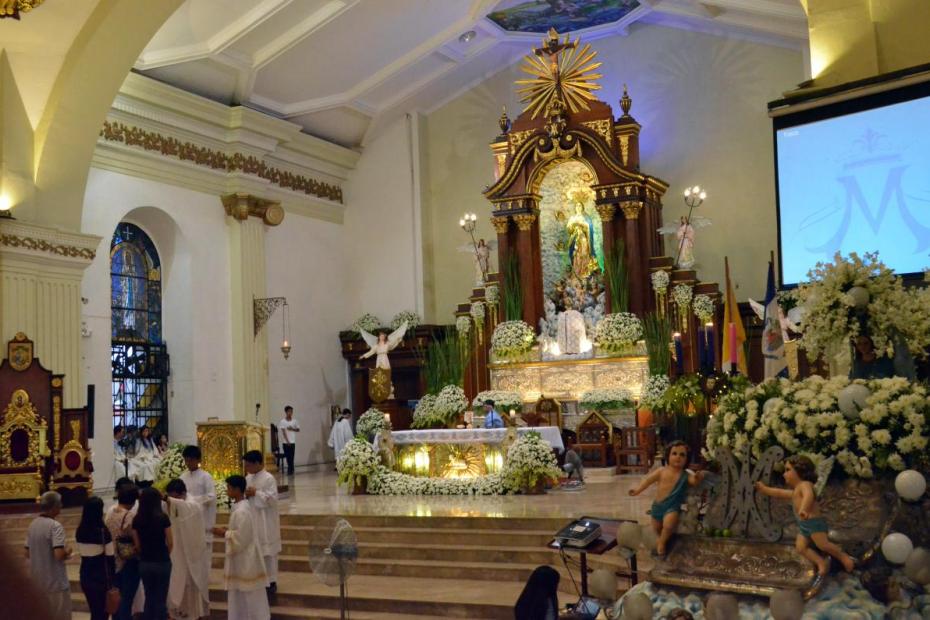December 8, the Feast of the Immaculate Conception, is celebrated with particular attention and ceremony in the Philippine Catholic Church. Filipino Catholics have an especially strong devotion to Mary. Under the title of the Immaculate Conception, she was declared Patroness of the Philippines in 1942. The Feast of the Immaculate Conception signifies that Mary, from the moment of her conception, was free from original sin. Devotees attribute many miracles to her.
Churches throughout the islands celebrate the feast with special devotion, but Malolos Cathedral, also known as the Minor Basilica of Our Lady of the Immaculate Conception, goes to particular lengths to celebrate the feast of its patroness. The cathedral, in the Bulacan province, is a celebrated church whose convent served as the presidential palace of Emilio Aguinaldo during the First Philippine Republic. The image of the Immaculate Conception is enshrined above the main altar and is especially venerated. The video and description on this page show parts of that celebration in 2014.
Feast of the Immaculate Conception at Malolos Cathedral, 2014.
Preparation
Months before the actual celebration, a special festival committee is organized to manage the feast. In 2014, Matilde D. Natividad, mother of Honorable Christian Natividad, the Mayor of Malolos City, was chosen as the Hermana Mayor, the head of the committee responsible for all the planning, implementation, decorations and fundraising.
The celebration of the Feast of the Immaculate Conception is preceded by nine days of Novena Masses, and the church is specially decorated for these Masses. The nine days also include a variety of cultural shows, talent shows, and livelihood training sessions.
During the Visperas, the day before the feast day, a brass band of about 20 players marches around the town to prepare the way. A family with a high economic status is usually assigned to finance the band and provide the food for that day.
The feast day
On the feast day, the main altar of the Basilica is lavishly decorated with white flowers. Masses start at 5 a.m. and continue every hour until noon, resuming again at 3 p.m., with a High Mass at 5 p.m. followed by the procession of the image of the Immaculate Conception. The procession, accompanied by the brass band, also includes many images of the patron saints of the different parishes of the Malolos diocese. In 2014 the procession pushed through despite typhoon Ruby’s strong winds and intermittent rain. The planning committee, which adorns both the church and the plaza, decorated the plaza with colored papers called banderitas hung from bamboo poles, big pictures of the Immaculate Conception, greetings and lights.
Interviewees at the celebrations indicated that they wanted to to venerate and honor Mary as their Patroness and show their love and faith. They believe that Mary intercedes for us to Her son Jesus. They also believe that by doing the nine-day novena, their prayers and petitions would be heard. Some even claimed to have experienced miracles by doing the devotion.
During the procession, a man with his face and body covered with small lumps kept wiping the image of the Immaculate Conception with his handkerchief during the procession, and then wiping it on the lumps on his face and body in hope of experiencing a miracle. The act of wiping the images of Saints with their handkerchiefs and then wiping it onto themselves or the parts of their body in need of a cure is called “punas-puna,” and is very common as a way of expressing faith and ensuring that the saint’s power will result in miracle. Elder devotees said that it is a tradition that was passed on to them by their parents and that they will pass on to their children and grandchildren.
Youth attendees said they celebrate the feast day because they were influenced by their parents and friends. Some who are studying in Catholic schools said that it was a holy day of obligation for the Catholic Church and that they are obliged to go to Mass. But there were also younger devotees who said that their love, faith and respect were the reasons why they celebrate the feast of the Immaculate Conception and that’s why they keep the traditions alive.
